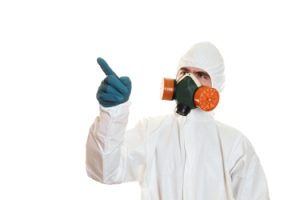Mold Removal Is Referred To As “Mold Remediation” Because Professionals Follow These 8 Steps

Our previous article explained why you should consider a mold inspection when you purchase a home. The purpose of this article is to outline why you need to hire a professional when you do find mold that needs to be removed.
DO NOT Hire Your Friend, The Contractor, To Remove Mold From Your Home!
One of the biggest concerns that most home owners have pertains to the cost of mold removal.
Because of the expense that mold removal poses, the human tendency is to try to find the best deal. However, be wary of contractors or friends that offer to remove your mold, particularly if they have no training or experience.
Do not fall for the sales pitch or claims that mold can be remediated with ozone or other types of machines that kill mold.
Another potential claim made by some removal companies is that they can just fog your home or spray a bunch of chemicals and the mold will magically disappear.
Contractors that offer these types of solutions are not professionals because they are just trying to kill the mold, which as we explained in a previous article, is not a proper method for long term mold removal.
Educate Yourself About Mold!
One of the reasons we post articles about mold is to educate our readers; an informed consumer is able to make better choices.
Moisture Is The Key!
Before addressing any mold problem, the most important concern is to first find the moisture problem that is causing the mold to grow in the first place.
Mold needs three ingredients.
First, a food source. Most homes present an ample food source for mold because they are made of dead material that mold loves to eat: high cellulose materials such as paper and wood, drywall, wallpaper, carpet, ceiling tiles, dust, and dirt.
Second, the right climate: mold flourishes when the temperature ranges from 41 degrees fahrenheit up to 100 degrees fahrenheit.
Third, and most importantly, a moisture source. Without moisture, mold can not thrive and grow. If you smell or see mold, then you have a problem because there is a moisture source in your home. Moisture is usually caused by leaks in pipes and/or the roof, sewer backups, flooding, condensation, etc.
There Is No Easy Fix For Mold Removal!
Any contractor that says there is an easy fix for mold removal, does not understand the biology of mold and does not realize that mold is designed to consume dead organic material and is an active part of our eco-system.
Unfortunately, the good that mold does by recycling dead material in our environment can cause significant harm when it grows indoors. First, mold can make you sick, causing asthma, sinusitis, and other health conditions. Second, as the mold eats away at your property, it will cause the wood to rot and eventually lead to structural integrity issues, ultimately reducing the value of the home.
When you encounter mold in your home, do not hire contractors that just want to tear out the contaminated materials and spray chemicals, particularly if their whole procedure involves killing the mold. It is not just about killing mold because dead mold spores can be just as harmful as live ones.
Mold is everywhere because it is a living fungi. The survival mechanism of mold is to disperse spores and find more areas to grow on and populate itself. When you have mold inside of your home, understand that the number one concern of mold remediation professionals is to prevent the mold from spreading, ie. to contain it and prevent cross-contamination. Then, once the containment is set up, the process of addressing the mold problem can begin.
Get YES Answers To These Questions Before Hiring A Contractor!
Before you hire any contractor to remediate the mold in your property, be sure to consider the following questions:
- Is the contractor prepared to give you a written contract/change order?
- Is the contractor prepared to provide you with a remediation plan?
- Is the contractor prepared to provide you with a post-remediation report?
- Is the contractor prepared to recommend independent indoor environmental professionals that can provide you with a post-remediation verification report? This is very important because this report determines whether or not the remediation has been successful.
- Does the contractor carry insurance?
- Are the contractor’s employees trained and certified?
- Does the contractor set up containment to prevent cross contamination?
- Does the contractor use negative air machines and air scrubbers to clean the air?
- Is the contractor willing to provide you with referrals and their contact details?
- Does the contractor use DOP (Dispersed Oil Particulate) tested equipment which is a process that tests the integrity of the HEPA (High Efficiency Particulate Air) filters used?
If you get NO answers to any of the above questions, then re-consider hiring this contractor.
Mold Remediation Professionals Are Building Doctors!
When you are sick, you go to a Doctor because you want the best treatment possible to get healthy.
Similarly, if you have mold, hire a mold remediation professional because they are Building Doctors, whose objective is to cure the property of toxic mold so you can live a better, healthier life.
Like health care professionals, mold remediation specialists take specialized courses and training to ensure that they can properly eliminate the mold problems of their customers.
To ensure a long term fix hire a mold remediation professional that uses the following 8 Step Mold Remediation Process.
8 Step Mold Remediation Process
Step 1: Assess The Cause of The Contamination
During the mold inspection, the professional consultant will identify the source of the water infiltration that is causing the mold contamination.
During this step, the consultant will also identify the extent of the mold growth to ensure that all areas of growth can be addressed.
The next step is to create a work plan, also known as a scope of work.
It is important that if the mold inspector you hire to do the initial investigation also does the remediation work, then a Third Party should be hired to do post-remediation verification, which is step 8 in the process.
Step 2: Identify the Species of the Mold
During the mold inspection, samples of the mold will be taken using swab or tape samples. Air quality tests may also be done. The samples are then sent to an accredited laboratory which will provide a report outlining what species of mold are present.
This report is important for three key reasons:
- This report is important because it helps the mold remediation professional determine the hazard level. Some mold species, like stachybotrys, pose greater hazards and may require additional safety procedures to protect the occupants of the property.
- Identifying the species also helps determine the most cost effective method to resolve the mold problem.
- Identifying the species can also help health care professionals determine if health concerns may be related to the mold contamination.
Step 3: Scope of Work
Once the investigation is complete, the remediation plan / scope of work can be completed.
This step is important because it addresses what caused the mold and all of the safety protocols required for the remediation to be successful.
Step 4: Containment, Decontamination Chambers & Negative Air
The area is contained and negative air pressures are set and regularly monitored to prevent cross contamination of mold spores and mycotoxins to other areas of the home.
During the mold removal and remediation process mold spores become disrupted meaning spore counts can increase 10 to 100 times.
Proper procedures, containment and HEPA filtration equipment are required to prevent cross contamination.
Without these controls, the situation can become much worse than the original issue.
Step 5: Removal of the Mold
Once the containment and decontamination chamber is set up, and required negative air pressure levels are achieved the mold is removed.
Mold damaged materials such as drywall, carpet, underlay, and other porous materials are removed and disposed.
Non-porous and some semi-porous materials can be cleaned and decontaminated.
Damaged or moldy materials that are removed are then bagged or sealed with plastic sheathing before removal from the containment to prevent cross contamination.
Step 6: Odor Removal
Mold contamination can create offensive odors such as a musty basement smell.
Carbon filters are utilized to assist in the elimination of odors from the area during the remediation process.
Specialized treatments and air cleaners may be required to ensure odors do not return in the future.
Step 7: Cleaning, HEPA Vacuuming & Air Scrubbing
Once the mold contaminated materials are removed, the area must be thoroughly cleaned using antimicrobial treatments on hard surfaces and HEPA vacuuming on the porous surfaces to remove the residual mold spores.
The air must also be scrubbed and purified to remove mold spores and mycotoxins using approved DOP tested HEPA air scrubbing equipment.
Step 8: Post Remediation Verification
Post remediation verification must be conducted by an approved third party to ensure that the environment has been brought back to a normal fungal ecology suitable for occupancy.
The final clearance investigation must include a visual inspection using specialized instrumentation and a full range of air quality and surface sampling.
Questions? Mold B Gone is here to help! If you think you have mold, call us, 678-697-6267 or contact us via e-mail for further assistance.
Our goal is to help you live a healthier and happy life.
Most importantly, we truly empathize with your situation and are committed to helping you and guarantee our services.
8 Steps To #Mold Remediation Success!: Mold Removal Is Referred To As “Mold Remediation” Because Professionals Follow These 8 Steps. This article explains the steps and why you need to hire a pro!
Posted by Mold-B-Gone Remediation, LLC on Friday, October 23, 2015
8 Steps To #Mold Remediation Success! https://t.co/lPZWqGvAjK PLS RT pic.twitter.com/7YQCGENgIx
— Mold B Gone (@moldbgonega) October 23, 2015

